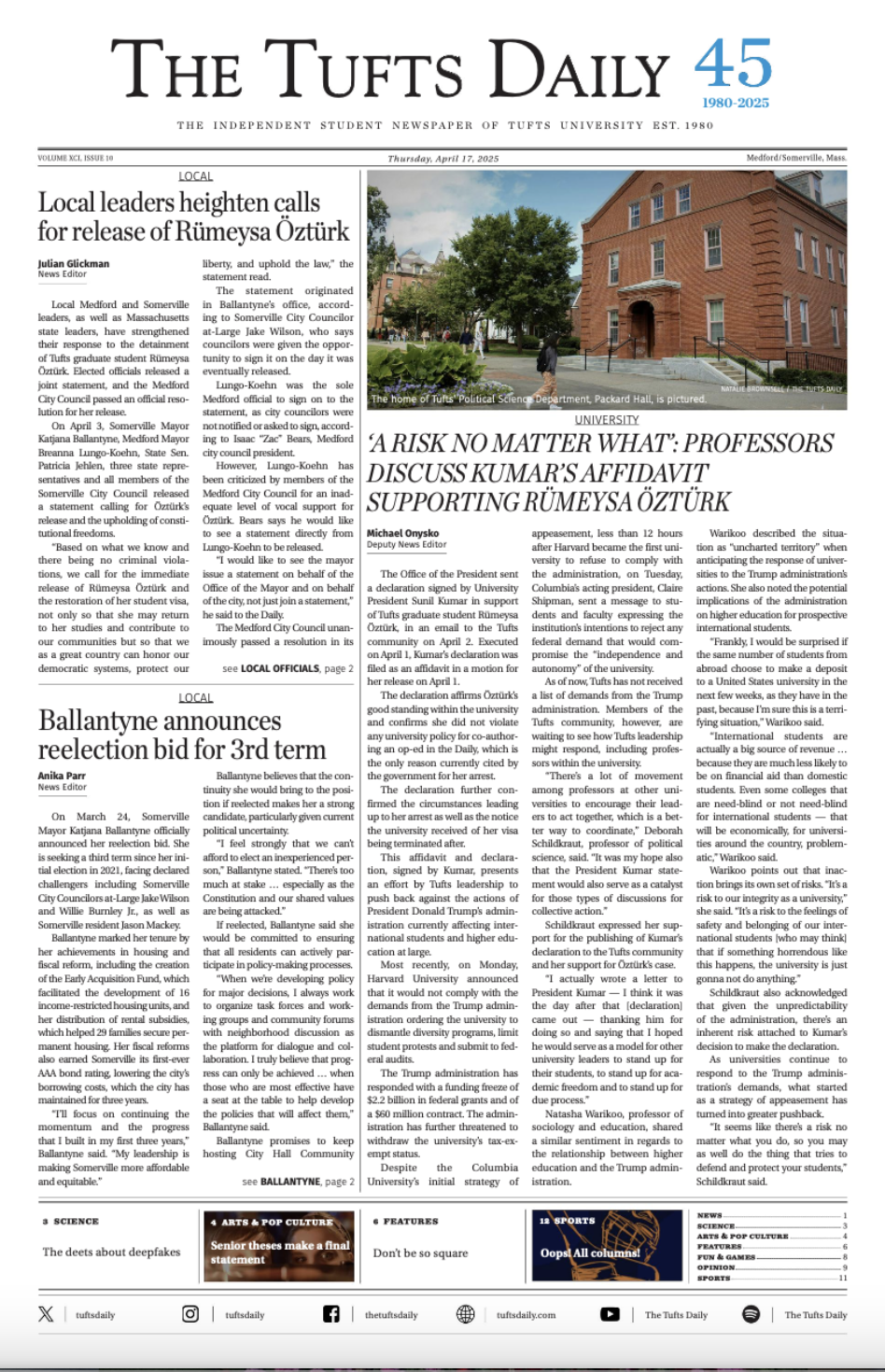Boston-based movement artist Miranda Lawson performed in the Tufts Dance Program’s Dances at Noon series on Friday. The series is put on by the Tufts Dance Program, a part of the Department of Theater, Dance, and Performance Studies. In 2013, Senior Lecturer Daniel McCusker founded Dances at Noon as a way to connect the dance program to the larger Boston area dance scene.
For the latest installment of this initiative, Jenny Oliver, head of dance performance, curated a showcase of work by one of her former students. Lawson graduated from Mount Holyoke College in 2022 with a bachelor of arts in dance and psychology.
The solo performance began with a spoken word poem where Lawson looked into audience members’ eyes and asked, “Where do you go?” Dressed in a monochrome bubblegum pink outfit, the artist touched on themes of anxiety and overthinking in spoken word poetry before Gnarls Barkley’s “Crazy” started playing. Once the upbeat pop song began, Lawson started moving through the Jackson Dance Lab in a style recalling hip-hop, contemporary and house.
This first work in progress titled “cRaZy” builds off of her recent one-woman show, “qUaRtEr LiFe cRiSiS,” and challenges the many norms and conventions of traditional dance creation. “cRaZy” fuses together pop, country and techno music by featuring Gnarls Barkley’s “Crazy” and Patsy Cline’s “Crazy” in a mix punctuated by glitches and a disturbingly long repetition of the sound “hahaha,” evoking feelings of paranoia and insanity.
“I love to make the audience uncomfortable and stare at them for so long, or do something right at them,” Lawson said in an interview with the Daily. “I love to see the way that they react and become involved.”
During a brief transition period where Lawson changed costumes behind a curtain, Oliver praised Lawson’s ability to integrate props, diverse music and spoken word poetry in her performances.
In her second work in progress, “1v1,” Lawson came out onto a dimly lit floor dressed in baggy shorts, a white tank top and a durag to the sounds of the start of a boxing match. The theatrical lighting set the stage for the artist to run in a circle around the room before stopping to stare down the audience.
“When I’m in one spot for too long I’m like, ‘Ugh, this is boring, gotta move. They must be losing interest, gotta move,’” Lawson said. “I try to challenge myself with how much ground [I can] cover.”
Resembling a boxing match, the piece was divided into four ‘rounds.’ After the first round, Lawson walked across the space like a ring girl carrying a piece of paper that read “Round 2.” During the second round, she danced to a mashup of three songs, including Chappell Roan’s “Good Luck, Babe!,” that layered onto each other before devolving into chaotic noise. Her musicality stood out in this segment as she moved in a way that highlighted her sharp lines and strong background in several dance styles.
Round three featured yet another Chappell Roan song, “Pink Pony Club,” but with another unexpected twist of repetition. During this segment, Lawson performed bits of several iconic dances, including the hand jive and the running man. The four rounds concluded with a sign that read “Time Out?” and Lawson retiring to lay on the floor upstage.
While lying on her back, the low light accentuated her laborious breathing and the light hand drumming on her chest. “I gotta find peace of mind,” Lawson sang from the floor before beginning her spoken word poetry. Ostensibly because this was a showing of works in progress, Lawson was reading from a piece of paper; however, a significant part of her work is based on improvisation.
“I’m fascinated by improvisation and being in the moment and seeing what happens,” Lawson said. Because of her background in psychology, the artist is interested in “the different thinking patterns that people have: How do those manifest in [the] body?”
During a brief post-performance discussion with the artist, Lawson shared that almost the whole performance had been improvised. She said that some of the ‘scores’ — guidelines used to guide improvisational work — she used were acting boneless, spineless and devoid of limbs. Despite the challenges of solo performance, Lawson described the vulnerability as “the only way she exists.”
Lawson is a member of the Urbanity Dance Company in Boston’s South End and will perform as a soloist in Urbanity’s fall dance crawl “Go Stop Listen. Still Wait Go.” from Oct. 17–19. She hopes to build on the two works in progress she showed at Tufts in the near future.
“I’m building a third section and hoping to get that together and have a full performance with lighting and everything … at the very beginning of 2025,” Lawson said.
Dances at Noon is a recurring series that is free, open to the public and an excellent opportunity for the Tufts community to watch some amazing and inspiring dance performances from local artists.






